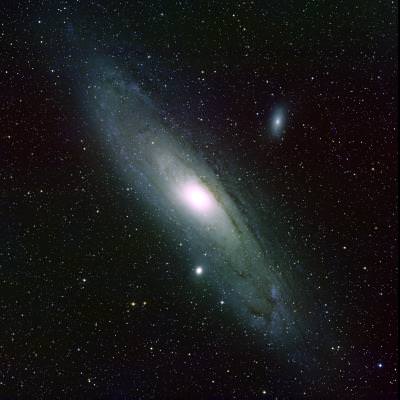Within our own galaxy, the thick disc is a distinct population of stars that resides above and below the main (thin) disc. Its stars have a larger range of velocities, are generally older and more metal poor. While astronomers aren’t entirely sure how it formed (remnants of accretion of small galaxies or ejection from the thin disc), it’s certainly there and analogues have been observed in other galaxies, more than 10 megaparsecs away. If these thick discs are truly a product of mergers, then galaxies showing evidence of mergers in other regards should show the presence of this second population as well. Yet in the case of M31, the Andromeda galaxy, the closest major galaxy to our own, which is thought to have a rich merger history, traces of the thick disc have proved elusive. So where is it?
Part of the problem in finding this galactic component is the angle at which the galaxy is presented to us. The galaxies for which a thick disc component have been detected (aside from our own) all lie edge on. This makes the process of finding the thick component greatly simplified. Astronomers can use photometric systems designed for detecting different populations of stars (young vs. old) and observe the change in distribution. When galaxies are presented closer to face on, the projection of the thick component onto the thin makes the identification far more difficult. The Andromeda galaxy is somewhere in between these two extremes and makes an angle of 77° on the sky (where 90° is edge on).
Due to this difficulty, another method is necessary to search for this extended population. Since 2002, a team led by Michelle Collins of Cambridge university has been using the Keck II telescope to search for the expected disc. To do this, the team has been using spectroscopic observations of numerous red giant stars to determine if a specific sub-population can be found with thick disc characteristics. While a sub-population has been discovered before in M31, its velocity dispersion was too low, and the distribution was too closely tied to the classical thin disc to truly be considered the missing component. Instead, it is referred to as the “extended disc”.
But where others have failed, Collins’ team has prevailed. From her team’s study, a recent paper claims to have discovered the thick disc and with such a large sample, have made some interesting observations about its nature. The first is that M31’s thick disc is nearly three times as thick. Additionally, the average velocity of both the thin and thick discs are notably higher (thinM31 = 32.0 kms-1, thinMW = 20.0 kms-1; thickM31 = 45.7 kms-1, thickMW = 40.0 km-1). If the thick disc is indeed related to mergers, then this may indicate that M31 has undergone a more intensive period of recent interactions than our own galaxy. However, the team notes that, from their observations alone, they are unable to constrain the formation methods of this component. While other studies have shown that accretion and ejection each leave distinct fingerprints, the necessary components were not mapped in sufficient detail to distinguish between the two.


Maybe I’m thick, but shouldn’t “thick” be “thin” here? (Else what is the “the classical thick disc”, how could a tie with it disqualify the mentioned sub-population and why would it be the “extended disc”?)
“Maybe I’m thick”, but not as thick as M31 I hope: these are interesting observations I meant to say. Assuming the same (or more!) stars in M31 thick disc combined with their much larger average kinetic energy (goes as v^2), would such drastic imprint of relatively recent interactions stretch to other observed M31/MW differences? I’m thinking of differences in star and cloud characteristics.